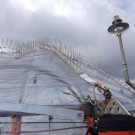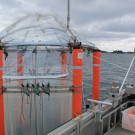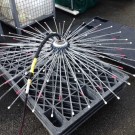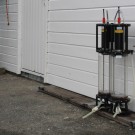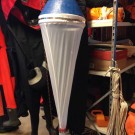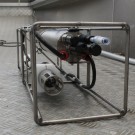What are the instruments scientists used for? It may be mysterious to most of people. Today, let’s get a short impression by going close into a field study of ocean acidification.
KOSMOS
It is a close system. KOSMOS is like a floating iceberg. Don’t be misled by its part above water. In fact, the total height of it could be more than 20m. The exquisite design of KOSMOS can be seen even from the details of the roof. The plastic roof could protect system from rain. Lines and loops are well organized around roof which enables the system to function well for any experiment or sampling requirement. The spines and night lights on the roof may look strange at first glance. But, if you have seen numerous birds and boats around coast, all of these little spines and night lights will make sense.
Spider and Integrating Water Sampler
Spider is a very important instrument in this study. To simulate the increasing pCO2 scenario in the future, water which is fully bubbled by CO2 will be added into the bottom of KOSMOS through Spider. It will go through the bold black tube, distribute into each direction by pipes, and then be well mixed with the whole water column. Adding water means that we don’t need to disturb everything in KOSMOS by bubbling with CO2 for hours and hours. The picture at the right side is our Integrating Water Sampler. Don’t be frightened by its structure. The function of it is simple: collecting water sample from a continuous depth and following by mixing procedures. So, it is called integrating water.
- Spider
- Integrating Water Sampler
Plankton net, CTD and Suit
As you can see, plankton net has a big open mouth, and then, gradually narrow down which could prevent zooplankton from escaping during sampling. CTD is the most fundamental instrument in ocean study. It is used to determine temperature, salinity, depth, pH, etc. There are not too many things you need to learn. Basically, the machine would do the measuring automatically.
- Plankton net
- CTD
Lifejacket is necessary. Unlike traditional lifejacket, the buoyancy filler is only in the front side for the lifejacket in here. This special design could make sure your head is always above water even after a strong wave. What else do we need? Maybe a safety boot or maybe a waterproof suit, no matter how many instruments you need, just keep in mind one thing that it’s not complicated. The more complicated it looks like, the much easier to operate. Have fun!
Cheers,
Xiaoqi

